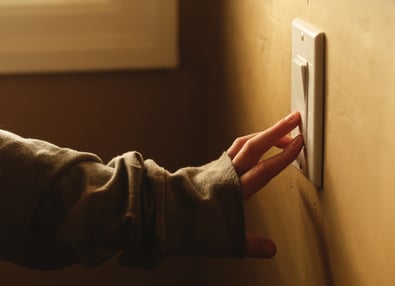Growing Up in a Deaf and Autism Household
The Story of My Brother Tommy
Growing up is never easy. Growing up in a hearing household with a brother who is deaf and autistic brings unexpected challenges, to say the least. Picture a rural family in the 1990s with no past interactions with people who are deaf or autistic and then enter a unique son to join his sisters: my brother Tommy.
There is often confusion in first recognizing autism and deafness—the family struggled at first to decide if the baby was just choosing to ignore sounds and didn’t want to try talking or if there was something wrong. It wasn’t until he was 15 months old that Tommy was diagnosed as deaf. Later that year he was evaluated for autism but didn’t check all the boxes because he had a strong preference for interacting with people. Two years later, doctors kept coming back to some degree of autism and noted at age 8 that Tommy had a “pervasive developmental disorder not otherwise specified” (PDD-NOS), and later confirmed his diagnosis as an intellectual disability (IDD) at age 10.
The combination of autism and deafness brought many unique challenges to our family. Here are some that stood out to me the most growing up in an autism/deaf home, and what we learned about ways to intervene and meet his needs.
1. How to get attention
Getting attention is a skill needed both by autistic children and those who are deaf, typically a sequence that involves waving, pictures, tapping someone’s shoulder, or saying their name if they can hear. With deafness, the options are narrowed.
Growing up and still today, Tommy is an especially fast walker. If we need to get his attention quickly, we can’t say his name and we can’t tap his shoulder so usually we’d have to sprint ahead to catch up to him. Here are some of the strategies we learned specific to the deaf community.
 Turn the lights off and on—This flash is a visual cue that will let others know that you need their attention.
Turn the lights off and on—This flash is a visual cue that will let others know that you need their attention.- Stomp on the floor or tap the table—The vibration from this action lets others know that you want their attention, and it is effective even if the communication partners are relatively far apart.
Tommy’s ornery streak often had him flashing room lights and stomping only for attention he didn’t need, but he largely outgrew this. We also learned the proactive use of sketching or pasting in picture icons to tell stories about the day could effectively bridge the communication gap.
2. Sleeping procedures
Growing up, my brother would always insist all the lights must be off at night, especially if he was going to sleep. He would turn every light off in the house and go up to his room—if he came downstairs and found that we’d turned on a lamp or one of the main lights, he would become very upset and immediately turn it off again. This was a very challenging behavior to deal with when I was a kid because I was afraid of the dark and couldn’t understand why he always wanted the house to be pitch dark. Once our family learned more about deafness and Tommy’s adaptations through autism, it started to make more sense.
- Lights = awake. We learned over time that Tommy is an incredibly light sleeper. If he feels the vibration of a door being shut or someone walking, he will immediately be up to check it out. Similarly, he’s very sensitive to light at night; not necessarily from a sensory issue, but because his sense of sight is incredibly attuned and he notices light more easily than most, even if his eyes are closed.
Over time he has learned to sleep with his blanket over his head to block out any additional light and variation. Through a lot of teaching and reinforcement growing up, he also learned that it’s okay for others to have a lamp on—especially if they aren’t in the same room as him!
3. Scheduling loud activities
We soon learned that just because someone is deaf, it does not mean they are quiet. In many cases, it can be the exact opposite when they are oblivious to the sound! One of the wonderful things about Tommy is that he loves to do chores—especially vacuuming, laundry, and running the dishwasher. The problem was, he lacked the awareness of how loud some of those activities can be. So I have many memories of hearing the vacuum cleaner going at 4 a.m. because he wanted to be helpful and clean the house! We figured out that what Tommy needed was a clear expectation of when to do those chores.
- Post-it note schedules—My parents started at an early age to build Tommy’s understanding of time by having him match activities to the time on the microwave’s digital clock. Initially, they would have him wait a very small amount of time (like 5 minutes) to match a preferred activity with the clock and then he was able to do that. Building on that, my parents stuck a post-it on the vacuum, dishwasher, and laundry unit to let him know he could do those activities when the time matches.
This strategy is still incredibly effective for Tom in his group-home setting, and he has been able to expand his concept of time to using his digital calendar on a device to know when to expect upcoming events.

4. Sensory input
Tying in with understanding sound levels, Tommy had some unique sensory inputs. We anticipated Tommy seeking more visual inputs than a hearing child because of his deafness. What surprised our family was some of the other sensory-seeking behaviors that we encountered.
- Screaming—As mentioned before, Tom is not the quietest person! As a child, he would scream often, even when he was by himself. This led us to talk with his school team and we determined that he liked feeling the vibration in his throat when he screamed. The team worked with Tom to understand appropriate voice volume and when it is a good time and place to seek that sensory input.
- Touch—The very challenging sensory input we encountered was his love for shaking people’s body fat! It was like he had a radar for whichever part of your body is a little extra squishy and he would even lift shirts at times to try to shake it. This took a while to overcome and he will still sometimes give my tummy a little shake. However, we found that he was more likely to do this behavior when he had downtime. So, we made sure to have his time fairly structured, or he was given exercise opportunities or a preferred activity for when he was at home. This has helped reduce the “Truffle Shuffles!”
5. Communication differences
There are many times when I am signing to my brother that people will ask me what he’s saying. I think there is a misconception that because he can use some sign language, he must be fluent. But just as hearing autistic people with IDD may not have the most coherent communication skills, the same goes for those who are deaf.
 Mumble sign: This means that Tommy will often say things in ASL that are indistinct or very subtle and make it difficult to understand what he’s saying. He is more likely to “mumble sign” if it is a non-preferred topic.
Mumble sign: This means that Tommy will often say things in ASL that are indistinct or very subtle and make it difficult to understand what he’s saying. He is more likely to “mumble sign” if it is a non-preferred topic.- Pantomiming: Probably due to his limited vocabulary and his lack of ASL communication partners, Tommy will often “act out” something he wants to tell me about. After more than a couple of decades chatting with my brother, I am probably an expert at reading charades about dishwashers, vacuums, lawnmowers, and laundry machines!
Despite these differences in communication, Tommy can be a very motivated speaker. He does know how to sign basic information about high-interest topics, write high-interest words, and make requests. He has started to use ProLoQuo2go on his device also, to make requests of communication partners who are not deaf.
I hope this peek behind the curtain into a deaf/autism household has resonated or given a new perspective on what life can look like with those two unique disabilities.
If you are also from a deaf/autism household, what are some things you’ve learned along the way that have helped with the unique challenges? Or is there anything else you’d like to know more about?

Frankie Kietzman, Ed.S.
Frankie Kietzman is a Sales Development Associate for STAGES Learning with experience teaching as an elementary teacher, self-contained autism teacher for elementary and secondary students, autism specialist and coach for teachers dealing with challenging behaviors. Frankie’s passion for supporting children and adults with autism originates from growing up with her brother who is deaf and has autism. As one of her brother’s legal guardians, she continues to learn about post-graduate opportunities and outcomes for people with autism. Frankie has a Bachelor’s degree from Kansas State University in Elementary Education, a Master’s degree in high and low incidence disabilities from Pittsburg State University and in 2021, completed another Master’s degree in Advanced Leadership in Special Education from Pittsburg State University.




